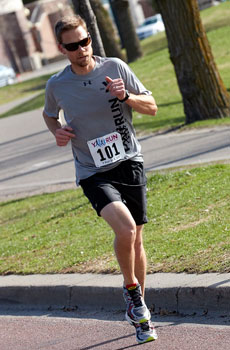Start training now for your next 5k or 10k run

Whether you plan to run a 10K (6.2 miles) or 5K (3.1 miles) distance, it’s a good idea to plan on at least two months of training before a race.
To help you prepare, a Personal Trainer at the Woodbury Y addresses a few common questions:
What can I do to ensure I have enough fuel for the race?
With a 5K or 10K distance, hydration is a critical factor. Rather than guzzling a bunch of water the day of the race, be sure to drink water and hydrate the day before the race. When you’re properly hydrated, your body will be more efficient.
As for food, the general rule is to eat carbs before a race (fuel for you to burn), and then be sure to get in some protein after a race (to help you recover). On race day, try to stick to a normal routine and have a light breakfast—don’t make it the day you try a crazy new breakfast.
What kind of running should I do to prepare?
Ideally, you should plan on running at least three times a week—one day focused on pacing (doing longer intervals at your race pace), one day focused on speed (doing short intervals at a fast pace) and one day focused on endurance (running longer distances). If you’re targeting five days of running a week, try to double up on endurance and speed workouts, leaving one day for pacing runs.
If you’ve been a consistent 5K runner and want to tackle a 10K, start increasing the length of your endurance runs, and remember that the challenge is largely a mental one.
For year-round runners in Minnesota, where to run is an important consideration. In the winter it can be challenging to get outdoors due to ice and cold temps. That’s why winter’s a great time to focus on speed training and shorter distances—easier to do indoors. That’s not to say you can’t run outdoors in the winter—just ensure you have the right gear for winter running. The gorgeous summer is a great time to get outside and run longer distances.
I’ve hit a plateau in my training—what can I do to continue to make progress?
Changing up your workout is important to help you keep challenging your body. In addition to running workouts, make time for cross training. The Y offers several free Group Exercise classes to members—logical choices for runners looking to cross-train include Strength and Yoga classes. Additionally, Trainer-Led Classes that are good for runners include Group Pilates Reformer, Kettlebells and TRX Suspension Training.
If you prefer to do your strength work solo, be sure to work on your legs and core (stomach, back and hips). Running really works the quads, so ensure your hamstrings are getting equal attention. And a strong core is a contributing factor to improved race performance and can help to reduce injury.
When you aren’t seeing the progress you want, remember that rest is important in a training regimen. If you don’t take time for your body to recover through rest, your body will have a harder time adapting to your training—and you won’t see the results you want.
One set plan won’t work for everyone—you need to find a training plan that works best for you and your goals. For example, if you’re new to running you’ll work out very differently from someone who has been competing in races for years. If you’d like help from a professional, a Personal Trainer at your local Y is a great place to start.